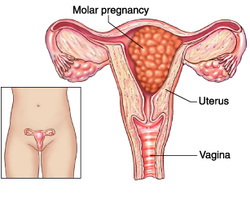Pathology definition - Hydatidiform Mole

Hydatidiform mole /molar pregnancy
Hydatidiform mole or molar pregnancy may present as large uterus for gestational age. There will be snow- storm appearance with no appearance of placental or fetal on the ultrasounds. Patient may complain of nausea and vomiting. Hypertension and painless bleeding of the vagina may occur.
Hydatidiform mole can be divided into complete hydatidiform mole and incomplete hydatidiform mole. Complete hydatidiform may present with edematous chorionic villi with cystic swelling. This resemblance of grape like cluster. There will be honeycombed uterus with hyperplasia of trophoblastic cells and absents of parts of the fetus. Incomplete hydatidiform or partial hydatidiform may present with some of the fetal parts with edematous changes of the villi. The treatment may include suction of the uterus for immediate emptying of the uterus.
Hydatidiform mole is caused by chromosomal abnormalities of the fetus. There will be complete mole which is 46, XX chromosomes and chromosome may derived from sperm.
Hydatidiform may also occur due to fertilization of ovum by multiple sperm which leads to partial mole triploid 69, XXY or tetraploid.There will be an increase in serum hCG.
Hydatidiform mole or molar pregnancy may present as large uterus for gestational age. There will be snow- storm appearance with no appearance of placental or fetal on the ultrasounds. Patient may complain of nausea and vomiting. Hypertension and painless bleeding of the vagina may occur.
Hydatidiform mole can be divided into complete hydatidiform mole and incomplete hydatidiform mole. Complete hydatidiform may present with edematous chorionic villi with cystic swelling. This resemblance of grape like cluster. There will be honeycombed uterus with hyperplasia of trophoblastic cells and absents of parts of the fetus. Incomplete hydatidiform or partial hydatidiform may present with some of the fetal parts with edematous changes of the villi. The treatment may include suction of the uterus for immediate emptying of the uterus.
Hydatidiform mole is caused by chromosomal abnormalities of the fetus. There will be complete mole which is 46, XX chromosomes and chromosome may derived from sperm.
Hydatidiform may also occur due to fertilization of ovum by multiple sperm which leads to partial mole triploid 69, XXY or tetraploid.There will be an increase in serum hCG.
